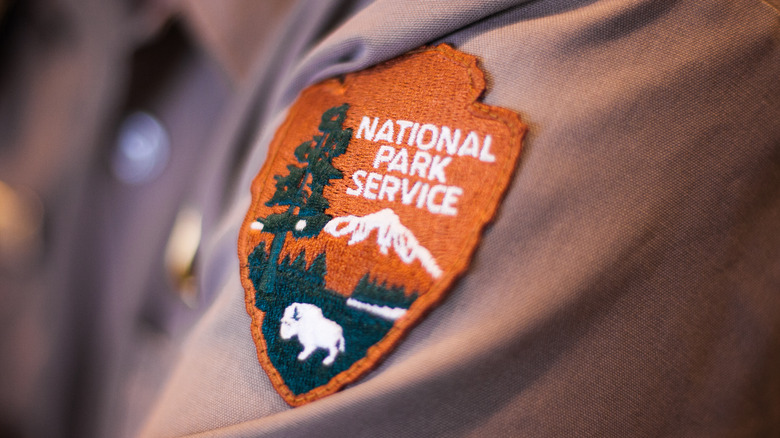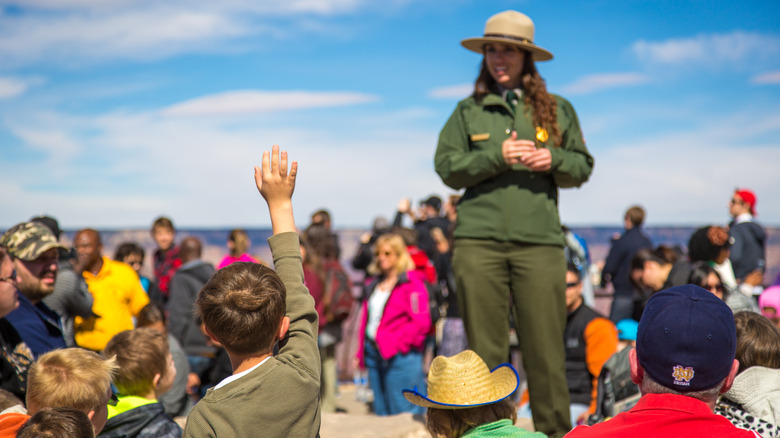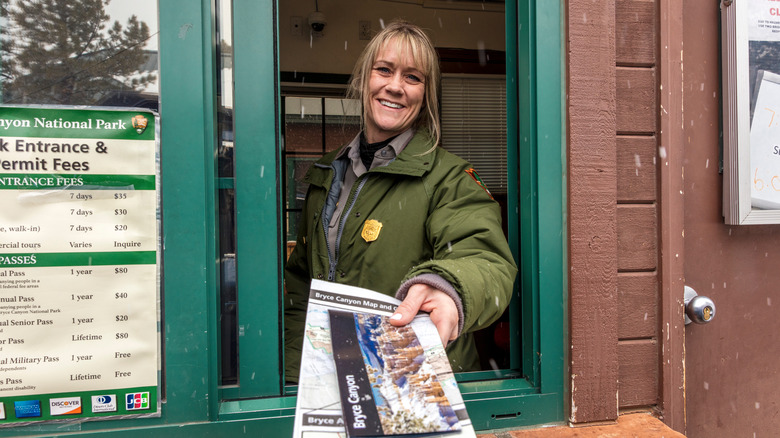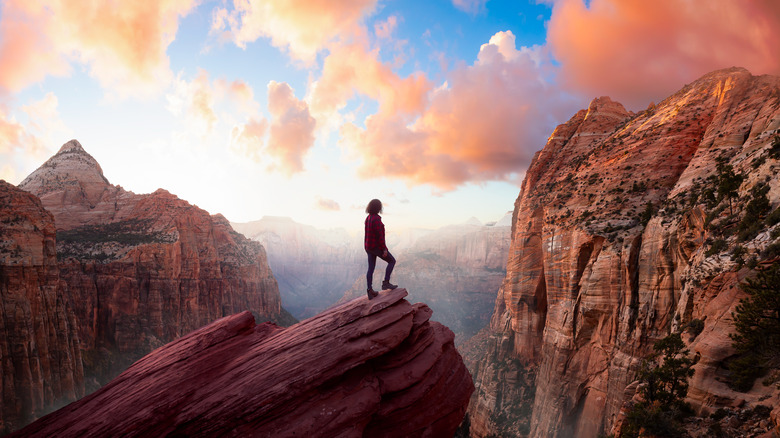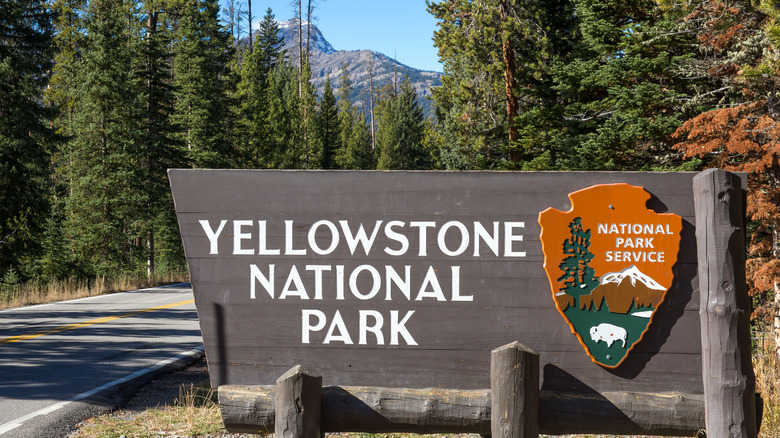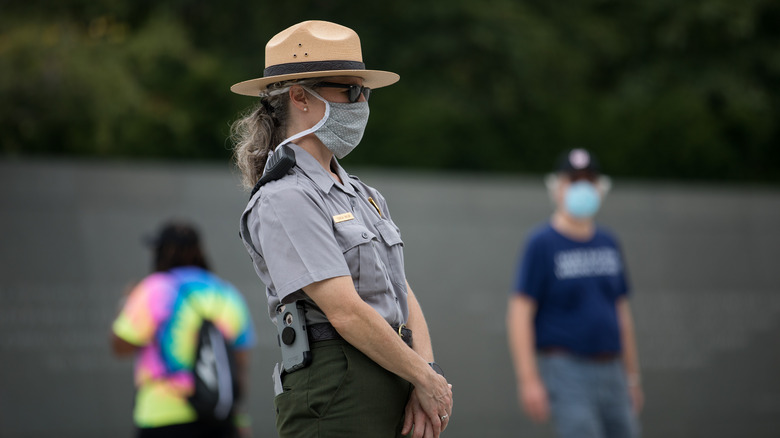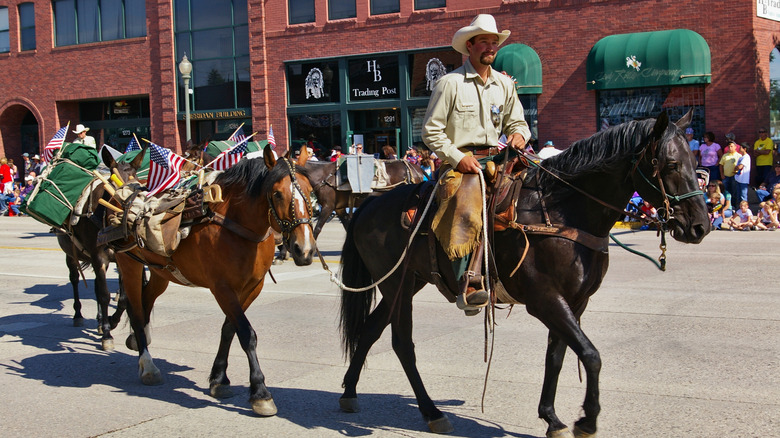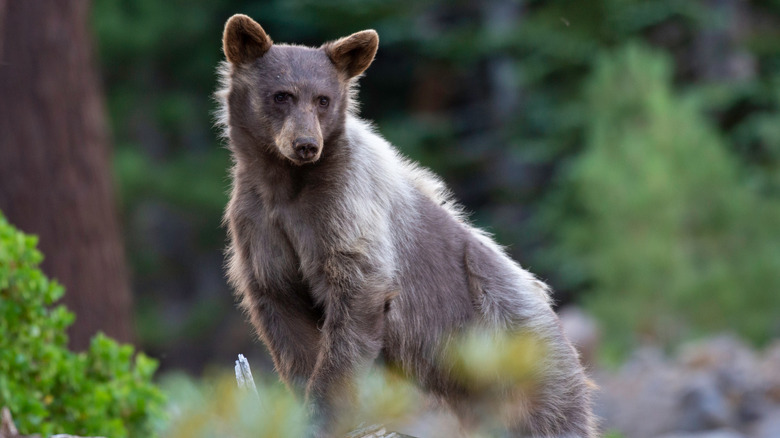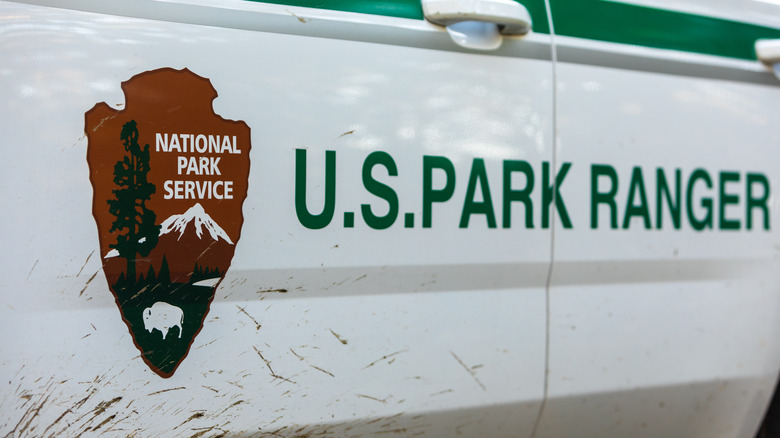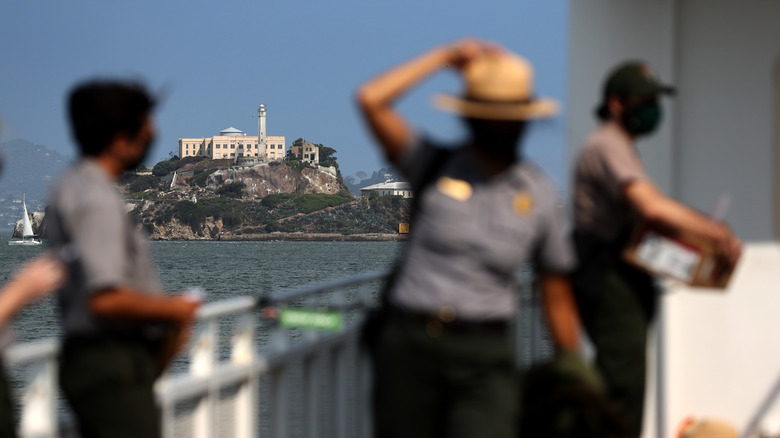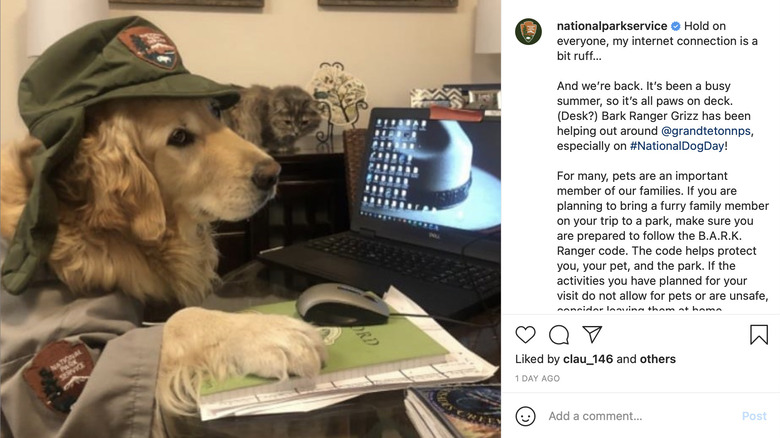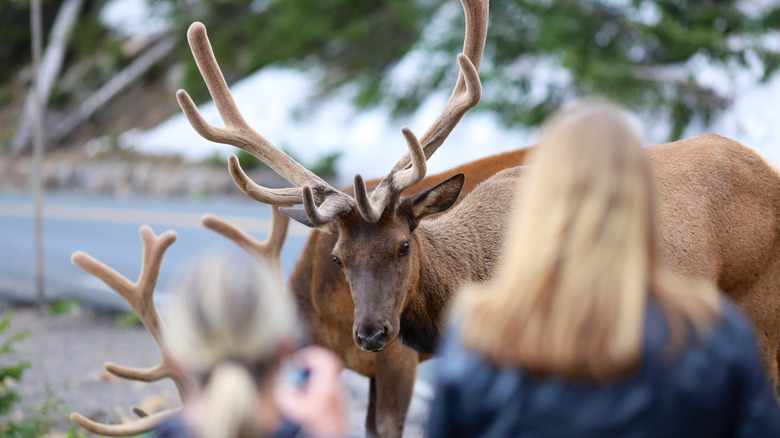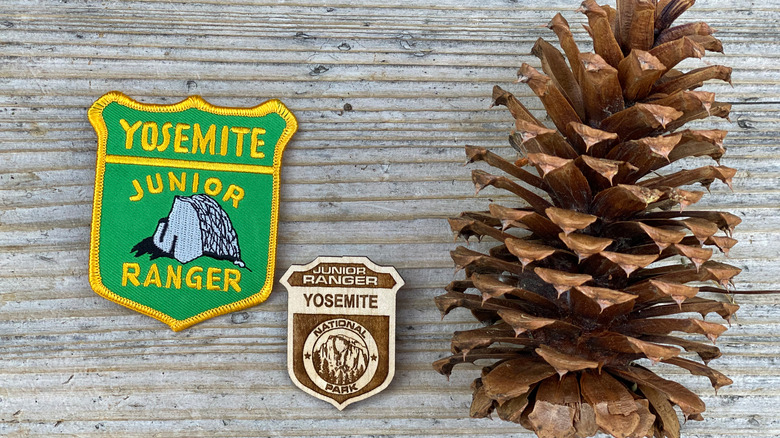What It's Really Like To Be A National Park Ranger
Ever wondered what it'd be like to work as a National Park Service (NPS) ranger? Or maybe you've even fantasized about living at one of your favorite parks? Either way, you're far from alone. If you're the outdoorsy type, it's hard not to get behind a job where you get paid to hike through some of the world's most stunning landscapes.
Of course, there's a catch to all this daydreaming. As it turns out, being a park ranger involves a lot more than hanging out in gorgeous locations. It requires the patience of Job when it comes to dealing with annoying, rude, and downright stupid tourists. And dangerous encounters with wild animals always proves a stark possibility.
And that's not to mention dealing with intoxicated or high individuals, escaped convicts, and even serial killers. After all, a "certain" segment of the population retreats to remote locations to partake in nefarious activity rather than sightseeing. So, what's it really like to work as a National Park Ranger? Here's what you need to know.
A National Park Service badge doesn't make them all Ranger Ricks
If you assume all NPS rangers are skilled mountaineers, botanists, or biologists, think again. The NPS also preserves national monuments, archaeological sites, battlefields, and other conservation sites, requiring employees with far-reaching talents (via NPS). What's more, maintaining national parks involves law enforcement, first responders, administrators, veterinarians, and public health employees. You get the picture.
In other words, there's more to the park service than the guys and gals who educate the public at visitor centers, according to the NPS. (These are the folks you recognize by their iconic flat-topped khaki hats and clothes.) You'll also find individuals employed in everything from scientific research to finance and budget, community assistance to search and rescue, as reported by the U.S. Department of the Interior.
What are some of the most fascinating and underrated careers with the NPS? They include working as a veterinary epidemiologist. These individuals must coordinate with the NPS to "prevent and manage human, animal, and environmental health issues." Some acoustic biologists work with the NPS' Natural Sounds and Night Skies Division. And marine pollution ecologists work to preserve and improve the health of coral reefs and seagrass.
Answering questions and passing out maps are just the beginning
What did you notice rangers doing the last time you visited a national park? Perhaps they answered questions at a ranger's station? Or provided you with directions and a map when you entered a park? Well, there's a lot more to the job than these two activities. Their other duties include patrolling the park, giving tours, collecting fees, coordinating education programs, etc. (via Park Ranger EDU).
What does a day in the life of a park ranger look like? According to The Balance, many rangers spend time reviewing permit applications and communicating with the public about special recreation permits. They may pass out and collect permits as well as fees for campsites. Many work out of a visitor's center where they keep databases on park visitor demographics and usage.
They perform traffic control and patrol park grounds to maintain visitor safety and security, assisting with recreation enhancement and volunteer stewardship projects. They may also conduct river patrols, monitor public and commercial river use, and clean campsites. What many don't realize is just how dangerous the job can prove. As reported by NPR, park law enforcement face "one of the most dangerous places" to work in the U.S. Why? Because they deal with remote territories (via Green Matters) that can be a free-for-all when it comes to criminal activity, from sexual assaults to armed assailants.
They get paid in sunrises and sunsets
Finding a workable balance between a career you love and one that brings in the big bucks remains a struggle for most people (via The Balance). This proves no less true when it comes to NPS rangers. Despite how complicated and dangerous working as a ranger can be, compensation starts at a measly $37,000 per year. And it tops out at $62,854, as reported by Salary. That said, those interested in this career don't do it for the money.
For this reason, there's an old saying among park rangers. They get "paid in sunrises and sunsets." As you know from the salary stats above, this couldn't be truer. But it's about much more than just breathtaking early morning and twilight skies. Rangers also have ringside seats to some of nature's most majestic sights, from pristine night skies to adorable wildlife.
What's more, they treasure seeing the park through the eyes of their visitors. As one ranger told Travel + Leisure, "It is so special to witness that 'aha' moment almost every single day ... I [also] love that I get to observe the ebb and flow throughout the seasons." Besides all of these benefits, many rangers also fall in love with wearing the Stetson (via Backpacker)!
National Park Service rangers must walk the walk AND talk the talk
Most careers come with a unique lingo, whether we're talking "pizzicato" and "tremolo" with classical musicians or "copy" and "CTAs" with content marketers. The same goes for NPS rangers. Some of the oldest national parks, like Yellowstone, boast regional terms like "Code W." According to Backpacker, this refers to a hiker who, not to put too fine a point on it, is the archetypal wimp.
No, they're not injured. And, no, they don't need rescuing. Instead, they feel tired and sore and are looking for an easy way out of their hiking predicament (rather than exiting on their own two feet). As a result, Code Ws are far from the rangers' favorite people. "The Code W is the reason the ranger has not slept in 24 hours. He is the missed lunch, the romantic dinner date stood up, and the stack of paperwork that's never finished."
But the colorful vocabulary doesn't end there, as reported by the U.S. Department of the Interior. Seasonal employees have long gone by the moniker "savages," and dishwashers are known as "pearl divers" (via NPS). Lodge maids enjoy the distinguished title of "pillow punchers," and horseback guides are known as "wranglers." According to NPS History, there's even an 85-page glossary of commonly used terms that rangers must learn.
Securing a job with the NPS takes dedication
Don't expect to get a job with the NPS on the spur of the moment. Securing a post requires years of planning, hard work, and dedication. It also comes with a willingness to volunteer and move from park to park as job openings come up. Many college students get their feet wet with the NPS by applying for the Pathways Program or Passport in Time. These programs permit individuals to earn a little dough while pursuing an internship with the Federal government.
People who want to become rangers must get their foot in the NPS door as soon as possible because the competition proves cutthroat. Sure, being an NPS ranger comes with low pay and plenty of work. Nevertheless, it remains a highly desirable job, with candidates nationwide vying for positions. How competitive? More than 200 candidates often apply for a single position, making these posts highly coveted.
What's the best strategy for securing a permanent post? Many different pathways exist as do many potential pitfalls. According to The Outbound, securing an internship represents "the gateway drug" when it comes to working for the NPS. Organizations such as the Student Conservation Association offer internships that can also help people work their way into the system. These programs introduce participants to the system while helping them network and develop contacts.
Some rangers don't work for the National Park Service
Remember that the NPS isn't the be-all, end-all when becoming a forest ranger. According to the NPS, plenty of other organizations also hire rangers. They include the U.S. Forest Service, the National Wildlife Refuge System, and the Bureau of Land Management. Depending on the state, other officials may also be known by the "ranger" moniker. Despite going by the same title, however, duties and overall employment foci may vary significantly.
What are the responsibilities of rangers with the NPS? They intersect around the central theme of "preservation of pristine areas." This focus on protecting historical and natural resources "unimpaired for future generations" informs everything they do. What's more, they operate under the Department of Interior.
How do these functions and administrative organizations compare to other ranger-managed institutions? Rangers for national forests focus on things like resource preservation along with other uses. According to the Forest Service, these multiple uses might include lumber, mineral products, recreation, hunting, and cattle grazing. For this reason, even when national parks and national forests abut one another, the rangers will participate in very different daily activities.
Rangers won't divulge all their secrets
Like other jobs that involve the public, rangers come away with plenty of fascinating and sometimes downright funny or bizarre stories, as reported by Mental Floss. Yet, they're not permitted to share some of their best tales. That said, now and again, you can get a former ranger interested in a little off-the-record chitchat. But assume they're keeping the best (and worst) tales to themselves.
Nevertheless, some stories are too good to keep to themselves. For example, former ranger Andrea Lankford divulged a few of her more fascinating stories to Backpacker. They include run-of-the-mill search and rescue, firefighting, and law enforcement activities coupled with more extreme situations. "I won arguments with bears. I dodged lightning bolts. I pissed on wildfires. I slept with rattlesnakes."
Other rangers have reported everything from finding corpses half-devoured by crows to observing the last frantic moments of an illegal base jumper whose parachute didn't open. For these reasons, rangers receive training as "critical incident stress counselors." They also spend time as temporary coroners. Despite the inherent horror of this aspect of the job, the most seasoned rangers remain surprisingly stoic. "They appear to be able to walk it off, shrug it off, laugh it off, and forget it." Yet, these moments of pathos and drama are juxtaposed with menial tasks. This weird dichotomy inspired one ranger to call the job "two parts action-adventure flick, one part 'Office Space'" (via Today).
It's not a job for the faint of heart
Working around the public and wildlife translates into unpredictable and sometimes downright dangerous situations, as reported by Chron. Rangers have experienced everything from encounters with bison, mountain lions, and rattlesnakes to dealing with inebriated or high visitors. Of course, there are also unsolved cases of missing rangers and the occasionally murdered ranger. After all, "not all visitors are peaceful families; criminals sometimes seek refuge parks to escape capture or commit crimes."
The hazards of working as a forest ranger go much deeper than finding a half-eaten dead body or dealing with a venomous snake in your boot. Some national park rangers have paid the ultimate price for their love of working in the wilderness. Many have died in the line of duty while protecting the park or members of the public. But others have been murdered in cold blood by everything from escaped convicts to serial killers (via Southeastern Outdoors).
What's more, violence can also go the other way, with rangers killing park visitors. In recent years, troubling cases have increased of what appear to be instances of excessive use of force. This includes one case, from June 2020, where a routine traffic stop disintegrated into a tragic shooting death per Outside. Are these incidents the result of short fuses? We may never know. NPR argues "the most dangerous place[s] to be a law enforcement officer" are America's nearly 400 national preserves and parks. In other words, these tragic escalations may have to do with burnout, PTSD, and other stress-related issues that come with the job (via NPR).
But most experiences with the public are great
Although things can spiral wildly out of control in some instances, most park rangers enjoy their experiences with the public, as reported by Mental Floss. Yeah, they have horror stories of annoying or stupid tourists, but these are juxtaposed with encounters with fascinating people. What's more, many rangers report that guests are generally well-prepared and practice good camping etiquette.
As Green Matters reports, life as a park ranger is "all about the people and the place. Most everybody who's a visitor is just excited to be there and in awe of the place." Witnessing the excitement of those exploring the wilds of America for the first time reminds rangers of all the reasons they wanted to go into this career in the first place. The excitement of guests is palpable, and lets rangers see the park with fresh eyes even as they provide advice on enjoying the best experience possible.
As Chief of Interpretation and Public Information at Haleakala National Park, Jin Prugsawan spends plenty of time working with the public. And she loves it, noting, "What appealed to me about the National Park Service and keeps me here has always been the people I am so fortunate to work with and meet in our parks" (via Travel + Leisure).
They're hilarious on Instagram
When rangers aren't busy rescuing lost hikers, promoting conservation, and fielding questions from tourists, they can be pretty hilarious. Especially on Instagram. The Trust for Public Land reports that the NPS has developed a kind of cult following because of the doozies they regularly post.
Not only do they use social media to bring public awareness to the plight of national parks and the wildlife living there, but they manage to make their message downright hilarious. No wonder the NPS' following sits at more than 3.6 million followers!
How does the NPS maintain the cheeky tone of their channel while still providing audience members with useful content? According to Matthew Turner, who runs the NPS' social media, "We could share these messages in a straightforward no-nonsense way, but if we can get the message out using some humor, or grab attention with a pop culture reference, we've often seen those posts, and their messages, really resonate."
Rangers have to deal with stupid
Rangers also have to deal with idiocy, and they see just about everything (via Stuff). From cliffside selfies ending in fatal falls to close encounters with wild animals, park visitors can be plain dumb. And rangers are usually the first on the scene to deal with the aftermath.
Perhaps the most famous of these cases was the story of the couple who threw a baby bison calf in the backseat of their car because they thought it looked cold. As reported by Traveller, the buffalo didn't require rescuing at all. What's more, their actions imperiled the calf, leading the mother to reject it. The outcome? The newborn had to be euthanized. But the dumb national park antics don't stop there.
Other "animal-related incidents" include tourists turned thieves in the Florida Everglades who attempted to snatch baby alligators. There are also far too many instances of visitors who attempt to take selfies dangerously close to wild animals. The outcomes can be brutal, if not downright life-threatening. Case in point, an adolescent boy taking selfies a mere ten feet away from a pair of adult male caribou. Fortunately, the animals didn't charge the young man, but rangers still point to how risky this behavior is.
They like educating a new generation of conservationists
Despite all this, rangers ultimately want to help visitors get the most enjoyment out of the national parks possible, as reported by Mental Floss. They enjoy taking questions and facilitating connections to nature, and many would like the public to ask more questions. What's more, some rangers admit to learning new things about the Great Outdoors from their guests.
One of the most enriching highlights of the gig? The chance to educate a new generation of conservationists. They do this through the Junior Ranger Program, per the NPS. Not only does the program allow kids to learn more about the national park system, but kids get hands-on training in biology, archaeology, paleontology, and more.
And it's not just kids that are interested in the program! Take the case of Rose Torphy, aged 103 (via the New York Post). The centenarian recently went through the program and became a junior ranger at Grand Canyon National Park. Torphy is living proof that age means nothing when it comes to enjoying the natural beauty of the National Park System.
